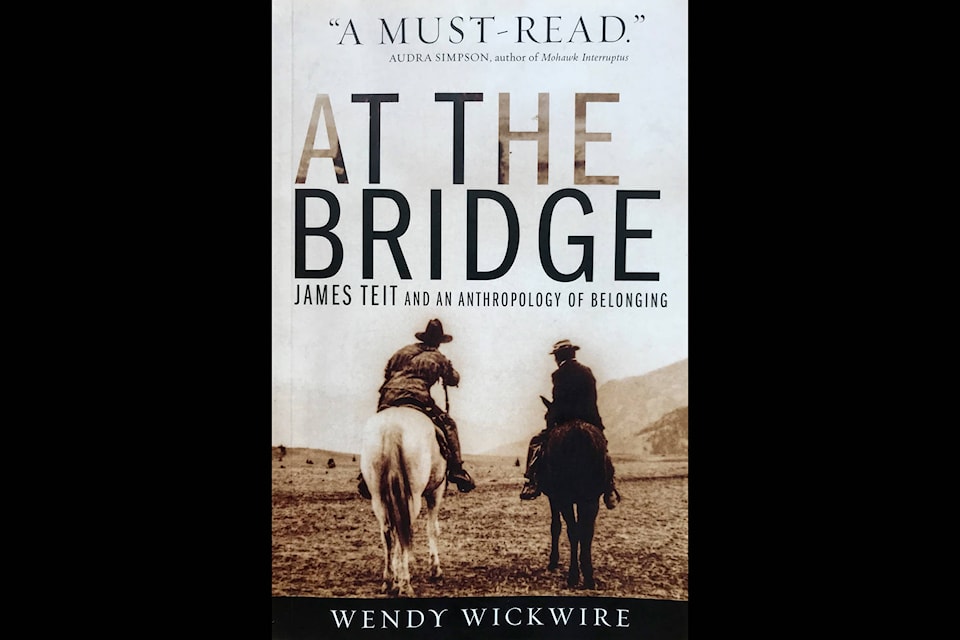It is an exceptional book about a remarkable man who never received the recognition he deserved for his major input to what was then the new science of anthropology.
Written by University of Victoria professor emeritus Wendy Wickwire, At the Bridge not only describes James Teit’s extraordinary life and achievements, but it also explains how his employers took him advantage of him and why the academic community discounted his vast contributions.
Wickwire begins the book with her own story about how she became fascinated with Teit and describes her many decades of research and writing about both Teit and Indigenous songs and storytelling. In some ways, Wickwire’s work with Indigenous elders carried on from what Teit began, as many of her books are collections of stories that have been passed down from generation to generation.
Teit immigrated to Canada from the Shetland Islands in 1884 at the age of 19 to work for his uncle at his store in Spences Bridge. He was part of a mass exodus of the islands, once ruled by Denmark,that was due to deteriorating economic conditions caused in part by the collapse of the fishery and an unfair political and economic system controlled by the wealthy few. Before he left, James was influenced by the Islands’ “free-thinkers” who challenged the establishment, explored their Scandinavian roots and pursued socialist ideals.
When the CPR pulled its construction camp out of Spences Bridge after the railway was completed in 1886, his uncle’s store had to close and Teit was forced to find other work. The backcountry skills he developed in the Shetland Islands helped him as he turned to hunting and trapping as a source of income. Within a few years, Teit became a foremost hunting guide and one of his loyal wealthy clients became a benefactor for some of his anthropological studies.
As Wickwire explains, Teit’s connections to Shetland’s Indigenous peoples helped him develop a deep respect for his adopted homeland’s Indigenous peoples that resulted in intense collaboration with them over his lifetime. Although most settlers scorned such unions, Teit’s marriage to Lucy Antko in 1892 further deepened his closeness to the local Nlaka’pamux people and likely helped him become fluent in their language.
When the young anthropologist Franz Boas stopped in Spences Bridge in 1894 as part of his ongoing studies of the province’s Indigenous peoples, he met Teit who then helped take cranial measurements. He soon realized that Teit, who had already begun studying Nlaka’pamux culture and history, was the ideal candidate to research and write a complete ethnographic report of the Nlaka’pamux.
Read more: Rare written history now online
Read more: Pioneer ecologist part of fascinating local history
Read more: Early archaeologist studied Secwepemc
Over the following 28 years until his death in 1922, Teit completed 11 monographs, collected hundreds of artifacts, made many wax-cylinder recordings of songs and stories, and produced thousands of pages of unpublished notes and drawings. Only a few of Teit’s ethnographies were published under his name, as much of his work was under-credited and in fact, plagiarized.
Although Boas was both his mentor and major employer, Teit’s research technique and style described as “participant-based” was in sharp contrast to Boas, who remained an aloof observer. While Boas worked to document what he considered to be a dying primitive culture, Teit studied those who he lived with and befriended. Wickwire describes Teit’s work as “an anthropology of belonging,” which is also the sub-title for her book.
As a result of his closeness to the people he studied and his own socialist background, Teit became intricately involved in the Indian Rights movement by actively campaigning for provincial and national organizations, often at his own expense. One of his most significant efforts was assisting the Interior Chiefs prepare the Memorial presented to Prime Minister Laurier in 1910 about the need for justice and fairness so that “wrongs may at last be righted.”
Given that much of what is known today about the history of the Secwepemc stems from The Shuswap, Teit’s seminal monograph, At the Bridge should be of interest to all those who want to learn more about this early ethnographer and B.C.’s Indigenous people. Thanks to Wickwire’s book, more people will become aware of Teit’s many significant achievements, and hopefully his reputation will gain the recognition it deserves.
@SalmonArm
newsroom@saobserver.net
Like us on Facebook and follow us on Twitter
